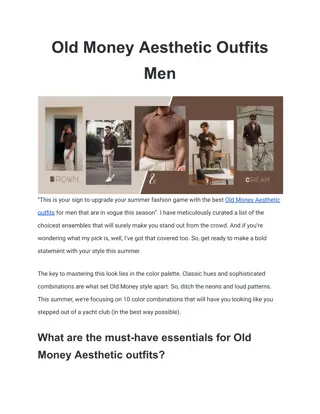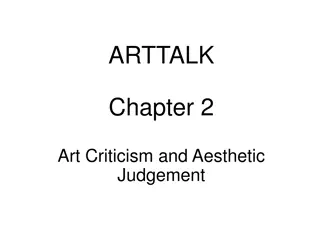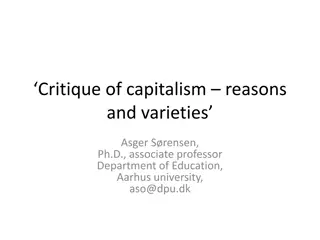The Ethics of Design: Aesthetic Movement vs. Capitalism in Industrial Design History
Exploring the Arts & Crafts Movement spearheaded by William Morris, Lewis Foreman Day, and the Aesthetic Movement that emerged as a byproduct. These design reform movements emphasized traditional craftsmanship, economic and social reform, and the pursuit of art for art's sake within the realm of industrial design.
Download Presentation

Please find below an Image/Link to download the presentation.
The content on the website is provided AS IS for your information and personal use only. It may not be sold, licensed, or shared on other websites without obtaining consent from the author.If you encounter any issues during the download, it is possible that the publisher has removed the file from their server.
You are allowed to download the files provided on this website for personal or commercial use, subject to the condition that they are used lawfully. All files are the property of their respective owners.
The content on the website is provided AS IS for your information and personal use only. It may not be sold, licensed, or shared on other websites without obtaining consent from the author.
E N D
Presentation Transcript
The Ethics of Design Aesthetic Movement vs. Capitalism History of Industrial design Lecture #5 Fall 2016 | INDS110C Adjunct: Troy Barber tbarber@ccsnh.edu
William Morris (1834-1896) Arts & Crafts Movement Theorist Contributor to the revival of traditional British textile arts and methods of production Close to other Pre-Raphaelite artists Founded Morris & Co. in 1875, whose goal was to produce reasonably priced, well-designed furnishings, wallpapers, and textiles while employing skilled craftsmen at fair wages
Byproduct of Design Reform Movement Espoused traditional craftsmanship using simple forms, and often used medieval, romantic, or folk styles of decoration. Advocated economic and social reform At its root: anti-industrial Arts & Crafts Movement (1880-1910)
Lewis Foreman Day (1845- 1910) Arts & Crafts Movement Theorist Glass painter & designer Influential educator who wrote extensively on design and pattern Started own firm in 1880 and designed textiles, wallpapers, stained glass, embroidery, carpets, tiles, pottery, furniture, silver, jewelry, and book covers
Aesthetic Movement (1870-1900) Byproduct of Design Reform Movement Left preoccupation with paternalistic standards behind Reconsidered sources of inspiration, materials, processes, and subjective meaning Freer and more individual approach to historical styles Greater freedom in use of materials and processes Art for art s sake after utility. Stressed simple forms and uncluttered surfaces, such as inlay, marquetry, cloisonn . Ornament was placed asymmetrically.
Advocated for the Aesthetic Movement Maxim of the Aesthetic Movement: 'Art for Art's Sake Decorative art must first have utility but may also be beautiful. Christopher Dresser (1834- 1904) Botanist, Industrial Designer
Candace Wheeler (1827- 1923) Interior Designer Mother of interior design One of America s first woman interior and textile designers Ambitiously promoted art and design as paying careers for women, rather than hobbies One of the first American women to produce designs for American manufacturers Paved the way for thousands of female designers who followed some of whom she trained in her woman-run firm, Associated Artists.
Henry van de Velde (1863- 1957) Art Nouveau designer & theoretician Belgian painter, architect, and interior designer Spent the most important part of his career in Germany In 1892 he abandoned painting, devoting his time to arts of decoration and interior design
Art Nouveau Movement (1890-1910) Inspired by natural forms, structures, flowers, plants, curvy lines Art Nouveau has a distinctive appearance; an Unlike the artisan- oriented Arts and Crafts Movement, Art Nouveau artists readily used new materials, machined surfaces, and abstraction in the service of pure design.
Coined the term conspicuous consumption, performances of which are performed to demonstrate wealth or mark social status Wrote The Theory of the Leisure Class Leader of the institutional economics movement Institutional economics focuses on understanding the role of the evolutionary process and the role of institutions in shaping economic behaviour. Thorstein Veblen (1857- 1929) Economist & Social Critic
Grant Information Get IT is sponsored by a $2.5 million grant from the U.S. Department of Labor, Employment & Training Administration TAACCCT Grant #TC-26498-14-60-A-33 NHTI, Concord s Community College, is an equal opportunity employer, and adaptive equipment is available upon request to persons with disabilities. This workforce solution was funded by a grant awarded by the U.S. Department of Labor s Employment and Training Administration. The solution was created by the grantee and does not necessarily reflect the official position of the U.S. Department of Labor. The Department of Labor makes no guarantees, warranties, or assurances of any kind, express or implied, with respect to such information, including any information on linked sites, and including, but not limited to accuracy of the information or its completeness, timeliness, usefulness, adequacy, continued availability or ownership.
NHTI information and Attribution NHTI, Concord s Community College 31 College Drive Concord, NH 03301 www.nhti.edu Creative Commons Attribution 4.0 International License INDS 110C History of Design curriculum by Troy Barber is licensed under the Creative Commons Attribution 4.0 International License. To view a copy of this license visit http://creativecommons.org/licenses/by/4.0/deed.en_US. http://creativecommons.org/licenses/by/4.0/deed.en_US























